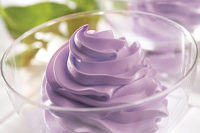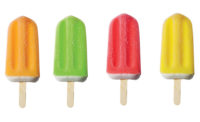No more paint-by-numbers
Such hurdles were no match for certified colors, which made coloring dairy products almost a “paint-by-number” process, Jonas said. Switching to natural, by contrast, involves a stepwise re-evaluation of the entire product and production process. “There’s no universal solution for a whole category,” he said.
Exempt colors simply aren’t as easy to work with as certified. For one, they can’t achieve the same intensity as certified options. “There is nothing like the brightness of synthetic colors, and no natural can replace them,” said Karina Bedrack, sales manager, LycoRed, Beer Sheva, Israel. “People want inexpensive exact shades of color in natural form, but that’s difficult to obtain with exempt colorants.”
What’s more, exempt colors will cost more than certified — as much as 10 to 20 times more on a cost-in-use basis, by some estimates. “The reasons for this,” said Ford, “are the costs of bringing the fruit or vegetable raw material to market versus, say, producing it in a lab. And use rates are typically higher with exempt colors, as there is more ‘stuff’ that comes along with them besides just pure pigment.”
Yet that higher price doesn’t buy more stability, as exempt colors are labile under many common dairy processing and storage conditions. “Unprotected pigments found in natural colors such as paprika, annatto, anthocyanins and carrot can degrade from exposure to heat or light,” said Carol Locey, director, product management, colors, Kalsec Inc., Kalamazoo, Mich. She added that the time/temperature conditions of heat treatment are also important to consider. “Colors with improved stability have been developed, such as Kalsec Durabrite colors.”
“In some cases, you may need to add a natural coloring at a different point than you would a certified color,” Renner-Nantz said. “For example, if you’re pasteurizing an ice cream, it’s possible that you might want to add the colors after the treatment because the heat will cause a little fading of naturally derived colors.”
Then there’s product pH and its effect on color. Though Locey said that turmeric “provides a bright yellow hue” at pH values from 2 to 7 — pretty-much covering the dairy spectrum — “certain annatto products sold as concentrates in alkaline solution can precipitate out in acidic conditions.” That’s why she advises using an acid-proof annatto when formulating, say, a yogurt.
Of course, it isn’t all downside when choosing exempt, as stability varies from colorant to colorant and condition to condition. Turmeric may fade in light but holds fairly steady at high temperatures; lycopene, paprika, annatto and carrot, for their part, are all relatively heat stable. Nevertheless, it pays not to take an exempt colorant’s staying power for granted.






